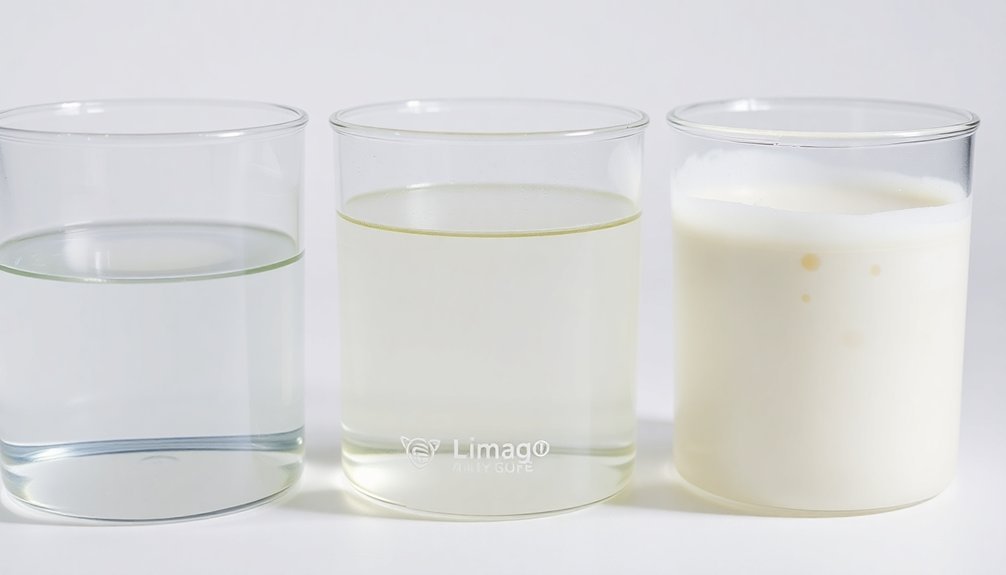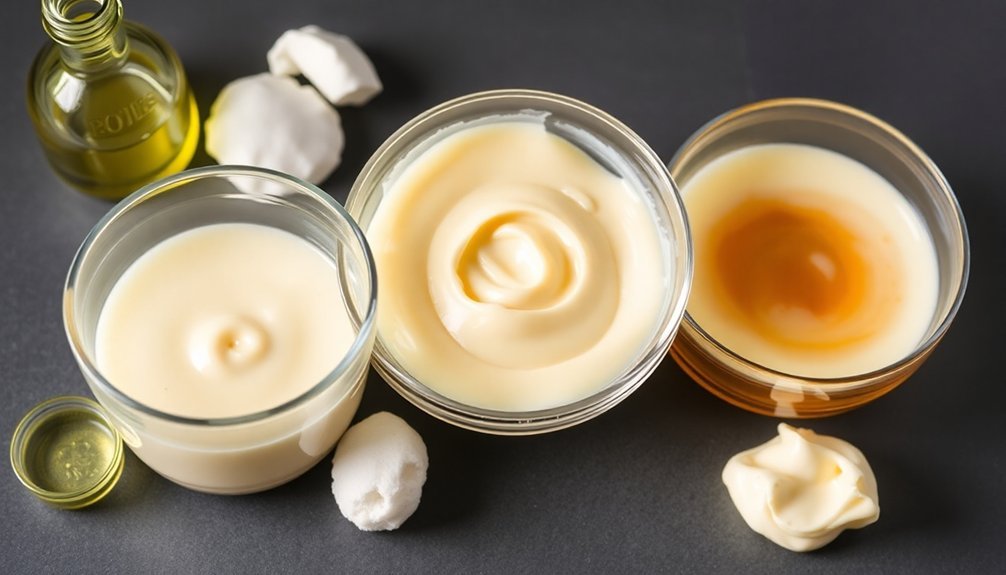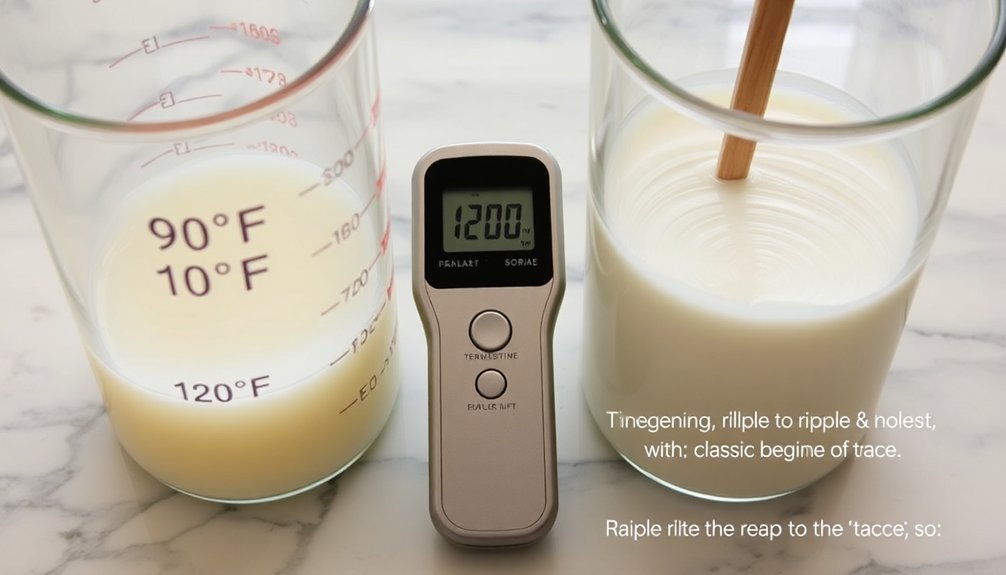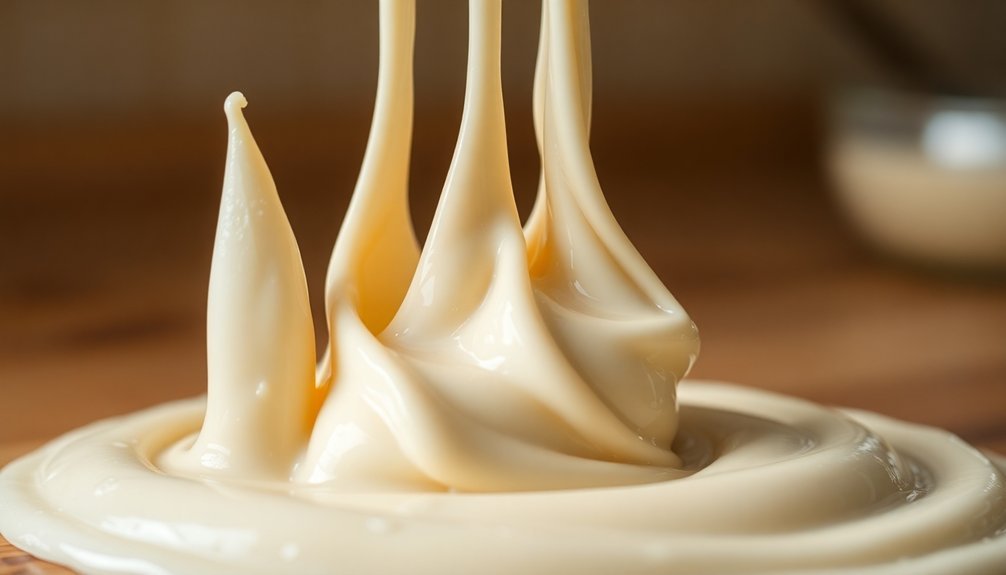Trace in cold process soap occurs when oils and lye water begin saponification, creating a visible thickening or emulsification of your mixture. You'll notice this when your soap batter leaves a visible trail on the surface when drizzled. Temperature, oil types, and mixing methods all impact trace speed—warm oils (100-130°F) accelerate it, while cooler temperatures slow it down. Hard oils like coconut trace faster than soft oils like olive. Your mixing technique, particularly using a stick blender, dramatically affects how quickly trace develops.
What Makes Trace Happen in Cold Process Soap?

When you combine oils and lye water in cold process soapmaking, a fascinating chemical reaction begins. This is where trace occurs—the moment oils and lye emulsify, signaling the start of saponification.
You'll notice the mixture thickening and becoming uniform as the ingredients react.
Temperature plays a vital role, with warmer oils (100-130°F) accelerating trace, while cooler temperatures slow it down. Your choice of fats matters too: solid oils rich in saturated fats speed up trace, while liquid oils with unsaturated fats extend the process.
Your mixing method greatly impacts timing—a stick blender dramatically reduces the time to achieve trace compared to hand stirring.
Be aware that additives like certain fragrances and clays can either accelerate or delay trace, so testing small batches is always wise.
Understanding the Science Behind Trace and Emulsification

Although many soapmakers recognize trace when they see it, the chemistry behind this crucial moment deserves deeper exploration. What you're witnessing during trace is the beginning of saponification—a chemical reaction where oils and lye combine to create soap molecules. During emulsification, these ingredients form a stable mixture that won't separate.
- Temperature greatly influences trace—warmer ingredients accelerate the reaction.
- Different oils achieve trace at varying rates, with some contributing to faster emulsification.
- Mixing techniques impact trace intensity—stick blenders accelerate it while hand stirring allows more control.
- False trace occurs when the mixture thickens due to cooling rather than saponification.
Understanding this science empowers you to better control your soap making process, allowing for precise timing when adding colorants, fragrances, and other additives at the perfect trace consistency.
How Different Oil Types Affect Trace Speed and Consistency

Every oil in your soap recipe brings its own personality to the trace party, markedly impacting how quickly your soap batter thickens and its final consistency.
Solid or "hard oils" like coconut and palm contain higher saturated fatty acid levels, accelerating the emulsification process and speeding up trace. In contrast, "soft oils" such as olive and sweet almond oil slow down trace, giving you extended working time during the soapmaking process.
Despite being unsaturated, castor oil can surprisingly accelerate trace due to its high ricinoleic acid content.
The percentage of oils in your recipe matters considerably—formulations with mostly hard oils reach trace faster than those dominated by soft oils.
Understanding each oil's fatty acid profile helps you predict trace behavior; for example, 100% olive oil soap recipes are renowned for their slow trace, making them perfect for complex designs.
Temperature Management: The Key to Predictable Trace

Three critical temperature factors influence how predictably your soap batter reaches trace. First, maintaining your lye and oils between 100-130°F creates ideal conditions for controlled emulsification during cold process soap making.
When temperatures fall too low, you risk false trace—where your mixture looks thick but hasn't properly saponified.
- Using an infrared thermometer provides precise temperature readings, eliminating guesswork
- Implementing a water discount accelerates trace speed by shortening the temperature phase of saponification
- Monitoring your workspace temperature helps maintain consistent conditions, especially in colder environments
- Ensuring all oils are properly heated prevents premature solidification that mimics trace
Mixing Methods and Equipment: From Hand Stirring to Stick Blending

The choice of mixing tool dramatically impacts your soap's journey to trace. Hand stirring, while traditional, can require hours of patience before emulsification occurs.
You'll find a stick blender revolutionizes your soap making process, cutting this time to just 1-2 minutes.
For ideal trace development, use your stick blender in short bursts rather than continuous operation. Pulsing prevents accelerated thick trace formation that can be difficult to manage.
Some crafters use equipment like the Magic Bullet, which can achieve trace in just 30 seconds—requiring even more careful attention. Alternate between blending and manual whisking for better control.
Don't forget your equipment matters too. Non-reactive metal pots and solid surfaces for molds provide consistent results and fewer complications during your mixing techniques.
Frequently Asked Questions
What Accelerates Trace in Cold Process Soap?
You'll see faster trace when you use stick blenders, add floral fragrance oils, include more solid oils/butters, mix in absorbent additives like clays, or discount water in your soap recipe.
What Is Trace in Cold Process Soap Making?
Trace is when your soap batter has emulsified and starts thickening. You'll notice it's no longer separating into oils and lye water, indicating saponification has begun. It ranges from light (thin) to thick (pudding-like) consistency.
Why Did My Soap Trace so Fast?
Your soap traced so fast likely due to your stick blender overuse, high saturated fat ingredients, warm temperatures, accelerating fragrance oils, or a water discount in your recipe. Try adjusting these factors next time.
What Is a Soap Tracer?
A soap tracer is the moment when your oil and lye mixture begins to emulsify during soapmaking. You'll notice it thickens from liquid to a pudding-like consistency, indicating saponification has started.
In Summary
You'll find that trace is your signal that saponification is underway. By understanding how your oils, temperatures, and mixing methods work together, you're in control of this critical soap-making moment. Whether you're seeking a slow, workable trace for intricate designs or quick setup for simple soaps, you've now got the knowledge to predict and manage this transformative phase in your cold process creations.





Leave a Reply